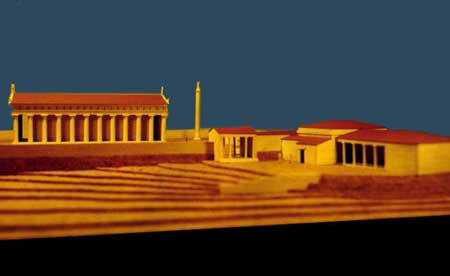
Book a hotel room in Athens Greece www.economyhotel.gr
check on line availability - prices and make a reservation https://economyhotel.cosmores.com
Afaia has been identified by numerous researchers as Britomarti, but also as Diktynna Artemis. The legend has it that Afaia resorted to Aigina and hided in a forest, in order to avoid the furious love of King Minoan of Crete. In this very forest, the Aiginites founded a sacred place to honour her. The temple was built for the first time around 570-560 B.C, but it was devastated by a fire. Around 500-490 B.C the temple took the form that we see today. Unfortunately, the holy place at the interior was not maintained for long time, since the decline of the island around the middle of 5th century. By 2nd century B.C the entire place wasabandoned.
The temple of Afaia retains a Dorian type of architecture and it is considered by many as the prototype designed by the architects of Parthenon. The temple has 12 columns across its length and 6 columns across its width. These columns are monoliths with 20 striations each, apart from 3 that are conjoined parts. Entering the temple was only possible through an inclining level at the eastern side of the temple. The sculptures on the frieze were made out of marble from the island of Paros. The theme of the two friezes of the temple of Afaia was the battles in Troy where Aiakides, Telamonas, Aiantas and Achilleas had many distinctions. Goddess Athena is present in every representation, justifying partly why many times the temple is named Afaia Athena.

The temple was left deserted for centuries, dominant in the landscape of the region, until two seemingly ‘Philhellenic’ Europeans initiated the first excavations in 1811; an English architect and a German baron, obviously after bribing some local authority, took off the sculptures on the friezes and transported them to Italy. From there they were sold to the German king Ludwig. Today these sculptures are showcased in Munich’s Sculpture Gallery and admired by many visitors of the city. Apparently, the Greek government in order to honour the Germans assigned the first scientific excavation in 1901, to the German Archaeological Institute. Fortunately, the last restoration work that took place between 1956 and 1975 was conducted by A. Orlandos and E. Stikas.
info: aiginainfo.gr